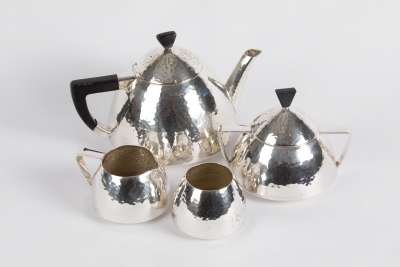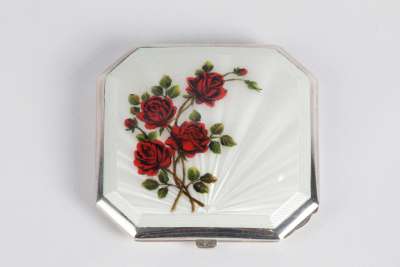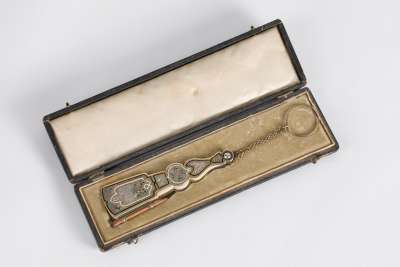A rectangular silver snuff box, crafted in the late 19th century by William H. Spencer, is symbolic of the craftsmanship characteristic of South Australian silversmiths. The piece showcases a hinged lid adorned with floral and foliate motifs, which are intricately hand-engraved. This level of detail is representative of the period's decorative style. The hallmark "SPENCER GAWLER" found on the interior of the lid denotes its origin in Gawler, South Australia, where Spencer operated between 1888 and 1894. The dimensions and refined detailing of this box reflect the artisanal quality associated with Spencer’s work, making it a notable piece in the collections of colonial silverware.
Condition Report
The snuff box is presented in very good condition, with the hinge functioning smoothly and the lid securing tightly. The engraved designs remain well-defined, while only minor surface scratches are evident, consistent with its age. The interior exhibits slight tarnishing, a standard characteristic found in antique silver items, but overall, the integrity of the piece has been well maintained.
Dimensions
Weight: 30gm, Length: 4.5cm, Width: 3.3cm, Height: 1cm.
A Personal Accessory for Tobacco Users
Designed originally as a personal accessory, this snuff box served to hold finely ground tobacco, known as snuff. In the 19th century, the practice of using snuff was prevalent in social settings, with such boxes often seen as markers of status and sophistication. Given its compact size, this particular box would have easily fit into a pocket or small bag, allowing the owner to carry it with ease and demonstrate their taste in refined personal items.
A Fine Example of Victorian Design
The floral and foliate engravings on this snuff box exemplify the Victorian era's detailed ornamentation and appreciation for natural forms. Such motifs were a staple of the decorative arts during this period, revealing the era’s fascination with intricate designs. The craftsmanship highlights the dual role of personal accessories as both functional objects and decorative statements, characteristic of Victorian sensibilities towards everyday items.
The Art of Silver Craftsmanship
William H. Spencer’s skill as a silversmith is evident in the meticulous hand-engraving of the box. The use of silver as a medium reflects the high standards of crafting in South Australia during the late 19th century. The delicate balance of functionality combined with aesthetic appeal illustrates the expertise involved in creating such pieces. The craftsmanship here signifies not only a connection to artisan traditions but also the social milieu of the time, where handmade objects were valued for their individuality and quality.
Crafted by the Renowned Silversmith, William H. Spencer
William H. Spencer played a significant role in South Australia’s decorative arts landscape. His work is frequently noted for its precision and quality, attracting collectors who appreciate the historical context and craftsmanship intertwined in his creations. The hallmark "SPENCER GAWLER" ensures authenticity and confirms its origin from a reputable maker known for producing sought-after colonial silver items.
Collected by Fans of Colonial Silver
Australian colonial silver, particularly items from the late 19th century, has garnered a dedicated following among collectors. Pieces like this snuff box are appreciated for their craftsmanship and as artefacts that provide insights into the daily lives and customs of their time. Collectors often seek such items to engage with Australia’s colonial history, making these antiquities valuable both for their aesthetic qualities and their cultural significance.















